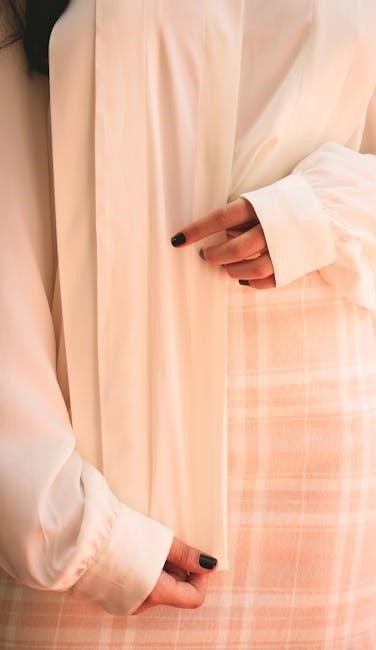Dress shirt sizing is crucial for comfort and style, yet many face challenges with inconsistent measurements across brands. This guide helps navigate proper fit, common issues, and key considerations to ensure a flawless, tailored look for every body type and occasion. Learn how to measure accurately, understand fit types, and convert sizes confidently.
Importance of Proper Fit
A well-fitting dress shirt is essential for both comfort and style. Proper fit enhances confidence, ensuring a polished appearance for any occasion. Ill-fitting shirts can cause discomfort, restrict movement, or look unflattering, undermining professionalism. A shirt that drapes smoothly across the chest, shoulders, and torso creates a streamlined silhouette, while correct sleeve and neck measurements prevent restrictive or sloppy looks. Proper fit also extends the shirt’s lifespan, preventing stretching or puckering. Whether for formal events, business meetings, or casual outings, a tailored fit ensures you look and feel your best. Accurate measurements and understanding your body type are key to achieving this. A proper fit elevates your overall style, making it a cornerstone of a well-curated wardrobe.
Common Challenges in Sizing
One of the most frequent issues with dress shirt sizing is inconsistency across brands, as sizes can vary significantly; This makes shopping online particularly challenging, as fits may not align with expectations. Additionally, measuring oneself accurately can be difficult, especially without guidance, leading to shirts that are too tight or too loose. Many individuals struggle with understanding their body type and how it relates to fit types, such as slim, classic, or athletic. Another common challenge is navigating size conversions between US and European standards, which can result in incorrect purchases. Finally, fabric type and stretch can impact fit, further complicating the process. These challenges highlight the importance of a reliable sizing guide to ensure a perfect fit every time.
Purpose of the Guide
This guide aims to simplify the process of selecting the perfect dress shirt by providing clear, actionable information. It addresses common challenges such as inconsistent sizing across brands, difficulties in self-measurement, and understanding fit types. The guide offers step-by-step measurement instructions, explains key measurements like neck size, sleeve length, and chest circumference, and outlines the differences between slim, classic, and athletic fits. Additionally, it covers size conversions between US and European standards, helping shoppers navigate international brands with confidence. By understanding fabric types, body types, and style considerations, readers can make informed choices. The ultimate goal is to ensure a flawless fit, enhancing both comfort and confidence, whether for formal events, everyday wear, or special occasions.
Understanding Dress Shirt Measurements
Accurate measurements ensure a perfect fit. Key measurements include neck size, sleeve length, chest, waist, and shirt length. These details guarantee comfort and style in any dress shirt.
Neck Size Measurement
The neck size is a critical measurement for dress shirts, ensuring the collar fits comfortably. To measure accurately, place a flexible tape measure around the base of your neck, just above the Adam’s apple. The tape should be snug but not tight, allowing one finger to slip under it easily. Take note of the measurement in inches, as this will correspond to your dress shirt size. Proper neck sizing prevents the collar from being too tight or too loose, ensuring both comfort and a polished appearance. For a slightly looser fit, add 0.5 inches to your measurement. Accurate neck sizing is essential for a professional and stylish look in any dress shirt.
Sleeve Length Measurement
Measuring sleeve length for a dress shirt involves determining the distance from the base of the neck, over the shoulder, to the wrist. Start by placing the tape measure at the center back of the neck, just below the collar. Gently extend the tape over the top of the shoulder, following the natural curve, and down to the wrist bone. Ensure the tape is snug but not tight, allowing for a full range of motion. Keep your arm relaxed and straight during measurement. This ensures the sleeve length is neither too short nor too long, providing a comfortable and tailored fit. Accurate sleeve length is crucial for both style and functionality, ensuring the shirt looks polished and feels comfortable throughout the day.
Chest Measurement
Chest measurement is a critical factor in determining dress shirt size. To measure accurately, wrap a flexible tape measure around the fullest part of your chest, keeping it horizontal and parallel to the floor. The tape should be positioned under your armpits and across the nipple line, ensuring it is snug but not tight. Take a deep breath and relax to ensure the measurement reflects your natural chest size; This measurement helps determine the shirt’s comfort and fit, ensuring it isn’t too restrictive or overly loose. Accurate chest measurement is essential for maintaining a polished appearance and allowing proper movement. It directly impacts how the shirt drapes across your body, making it a cornerstone of achieving the perfect fit. Always measure over a thin layer of clothing to simulate how the shirt will fit when worn.
Waist Measurement
Waist measurement is essential for ensuring a tailored fit, particularly if you prefer a dress shirt with darts or a slim silhouette. To measure your waist, stand upright and wrap a flexible tape measure around the narrowest point of your natural waistline, typically just above the hipbone and below the ribcage. The tape should be snug but not constricting, allowing for a full range of motion. This measurement helps determine how the shirt will fit around your midsection, especially when tucked in. A well-fitted waist ensures the shirt isn’t too boxy or overly tight, creating a balanced look. For accuracy, measure over a thin layer of clothing, such as an undershirt, to reflect how the dress shirt will sit. Proper waist measurement is key to achieving a polished, tailored appearance in your dress shirt.
Shirt Length Measurement
Shirt length measurement is crucial for ensuring the dress shirt fits appropriately, especially when tucked into trousers. To measure accurately, stand upright and place the tape measure at the base of the neck, just below the Adam’s apple. Extend the tape straight down to the desired shirt length, typically covering the waistband when tucked in. For most men, this ranges from the mid-fly to just below the back pocket for longer styles. Proper shirt length ensures the shirt stays tucked in without being too short or overly long. Consider your body type and preferred fit—slimmer builds may prefer shorter lengths, while taller individuals might opt for longer shirts. Accurate measurement ensures a polished, professional appearance, avoiding the shirt being too boxy or ill-fitting.
Types of Fit in Dress Shirts
Dress shirts come in various fits, including slim, classic, and athletic, catering to different body types and style preferences. Understanding your body type helps choose the right fit for comfort and aesthetics.
Slim Fit Characteristics
A slim fit dress shirt is designed to provide a tailored, contemporary look. It features a narrower cut through the chest, shoulders, and sleeves, creating a sleek, modern silhouette. The slim fit is ideal for those with a lean or athletic build, as it skims the body without being too restrictive. The shirt typically has a slightly shorter length, allowing it to be easily tucked into trousers for a polished appearance. Slim fit shirts often have higher armholes for improved mobility and a more streamlined look. They are popular for their versatility, suitable for both formal and semi-formal occasions. However, they may not be the best choice for larger body types, as they can feel tight. Choosing the right slim fit requires precise measurements to ensure comfort and style.
Classic Fit Features

A classic fit dress shirt offers a traditional, timeless silhouette with a comfortable, relaxed design. It is characterized by a slightly roomier cut through the chest, shoulders, and sleeves, providing ease of movement and a forgiving fit. The classic fit is ideal for a wide range of body types, including those with broader builds or prefer a more generous cut. The shirt typically features a longer length to ensure it stays tucked in and a slightly lower yoke for a balanced look. Classic fit shirts are versatile, suitable for both formal and business-casual settings. They are often preferred by those who value comfort without sacrificing style. The classic fit strikes a perfect balance between traditional aesthetics and practicality, making it a staple in many wardrobes.
Athletic Fit Description
The athletic fit dress shirt is tailored to accommodate muscular builds, particularly those with broader shoulders and chests. It features a slightly trimmer cut through the chest and sleeves compared to classic fits, while still offering a comfortable, non-restrictive feel. This fit is designed to highlight a strong, defined physique, with a focus on maintaining mobility. Athletic fit shirts often include a broader shoulder measurement and a nipped-in waist to create a balanced, V-shaped silhouette. They are typically crafted with stretch fabrics to enhance flexibility and movement. This style is ideal for individuals with an athletic build or those who prefer a modern, streamlined look without sacrificing comfort. The athletic fit bridges the gap between fashion and functionality, making it a popular choice for active individuals.

How to Measure Yourself for a Dress Shirt
To ensure a perfect fit, start by gathering a flexible tape measure. Measure your chest by wrapping the tape around the fullest part of your chest, keeping it level and parallel to the floor. For your neck, measure around the base, ensuring the tape isn’t too tight or too loose. Sleeve length is measured from the center back of your neck, over your shoulder, and down to your wrist. Your waist is measured around the narrowest part of your torso, typically just above your hips. Shirt length is measured from the base of your neck to your desired length, usually just below the hip. For accuracy, take measurements multiple times and consider enlisting help for harder-to-reach areas like the back and shoulders. This process ensures precise measurements for a comfortable and stylish fit.
Step-by-Step Measurement Guide

To measure yourself accurately for a dress shirt, follow these steps:
- Neck Measurement: Place the tape measure around the base of your neck, where the collar sits. Keep it snug but not tight. Ensure the tape is parallel to the floor.
- Chest Measurement: Wrap the tape around the fullest part of your chest, keeping it level and parallel to the floor. Do not pull the tape too tight or leave it too loose.
- Sleeve Length: Measure from the center back of your neck, over your shoulder, and down to your wrist. Your arm should be slightly bent for an accurate fit.
- Waist Measurement: Measure around the narrowest part of your torso, typically just above your hips. This helps determine the shirt’s taper.
- Shirt Length: Measure from the base of your neck to your desired length, usually just below the hip for a standard fit.
Take multiple measurements to ensure accuracy and consider having someone assist you for harder-to-reach areas. Record these measurements to compare with size charts for the best fit.
Essential Tools for Measuring
To accurately measure yourself for a dress shirt, you’ll need a few simple tools:

- Flexible Tape Measure: A soft, flexible tape measure is crucial for taking precise body measurements. It allows you to wrap it snugly around curved areas like the neck and chest.
- Full-Length Mirror: A mirror helps you see how the tape measure is positioned, ensuring accuracy, especially when measuring your back or shoulders.
- Pen and Paper: Record your measurements immediately to avoid forgetting them. This is especially important when comparing multiple measurements to a size chart.
- Fitted Shirt: Wearing a well-fitting dress shirt can help you gauge how you want the new shirt to fit, providing a reference point for adjustments.
- Assistant: Having someone assist with measurements, particularly for sleeve length and back, can improve accuracy and make the process easier.
These tools ensure you can measure yourself effectively and achieve the best fit for your dress shirt.
Measuring Tips for Accuracy
Accurate measurements are key to finding the perfect dress shirt fit. Start by using a flexible tape measure and ensure it’s level and not twisted. Measure around the widest part of your chest, keeping the tape snug but not tight. For sleeve length, bend your elbow slightly and measure from the center of your neck to your wrist. When measuring your neck, keep the tape loose enough to fit one finger comfortably. Avoid pulling the tape too tight, as this can lead to a shirt that’s too small. Take multiple measurements to confirm accuracy; Consider measuring in front of a mirror to ensure proper positioning. Lastly, measure over the clothes you plan to wear underneath the shirt for the best fit. Consistency is key to achieving precise measurements.

Dress Shirt Size Conversions
Dress shirt size conversions between US and European standards ensure a consistent fit when shopping across regions, helping avoid size mismatches and ensuring accuracy.
US to European Size Conversion
Understanding US to European size conversions is essential for ensuring the right fit when shopping internationally. US dress shirt sizes are based on neck measurements, while European sizes use a similar metric but with different numbering. Generally, a US size 14-14.5 corresponds to a European size 36, and a US size 17-17.5 aligns with a European size 43. The conversion involves matching the neck circumference in inches to the European centimeter-based system. For example, a 15-inch neck in the US is approximately 38 cm, fitting a European size 38. This conversion helps bridge regional sizing differences, ensuring accuracy and comfort. Always refer to a size chart for precise conversions, as slight variations may exist between brands.
European to US Size Conversion
Converting European dress shirt sizes to US sizes involves understanding the differences in measurement systems. European sizes are based on centimeters, while US sizes are in inches; To convert, add approximately 14 to the European size to get the US equivalent; For example, a European size 39 corresponds to a US size 15. This conversion applies to neck measurements, which are the primary factor in dress shirt sizing. However, it’s important to note that some European sizes may also include chest measurements, which can affect the fit. Always check the specific brand’s size chart, as slight variations may exist. Accurate conversion ensures the best fit and comfort when purchasing dress shirts internationally.

Factors Affecting Dress Shirt Fit
Fabric type, body type, and shirt style significantly impact dress shirt fit. Fabric affects comfort and drape, while body type and style determine silhouette and comfort levels.
Fabric Type Impact
Fabric type plays a crucial role in dress shirt fit and comfort. Cotton is breathable and soft, making it ideal for most body types, while linen offers a lightweight, cooling option for warmer climates. Polyester blends provide durability and wrinkle resistance, though they may lack the natural feel of cotton. Oxford and twill weaves are sturdy and maintain shape well, whereas pinpoint fabrics offer a crisp, formal appearance. Stretch fabrics, often blended with elastane, enhance mobility and fit for active individuals. The thickness and weight of the fabric also influence how the shirt drapes on the body, with heavier fabrics creating a fuller appearance. Understanding fabric types helps in selecting shirts that align with personal comfort and lifestyle needs, ensuring optimal fit and satisfaction.
Body Type Considerations
Body type significantly influences dress shirt fit. Slim individuals benefit from tailored or slim-fit shirts, which create a streamlined look without excess fabric. Athletic builds, with broader shoulders and chests, should opt for athletic-fit shirts designed to accommodate muscle tone. Larger body types may prefer classic or relaxed fits, ensuring comfort and avoiding constriction; Petite individuals should choose shorter sleeves and a slightly shorter shirt length for proportion. The shirt should skim the body naturally, neither too tight nor too loose. Measuring around the nape of the neck for neck size and ensuring the shirt falls just below the hip when untucked helps achieve a balanced fit. Considering body type ensures the shirt complements the wearer’s physique, enhancing both appearance and comfort.
Shirt Style Influence
Different dress shirt styles significantly impact sizing and fit. Slim-fit shirts are tailored closely to the body, ideal for those with a lean build, offering a contemporary look. Classic-fit shirts provide a traditional, comfortable fit with slightly more room in the chest and sleeves, suitable for various body types. Athletic-fit shirts are designed for broader shoulders and chests, accommodating muscular builds while maintaining a sharp appearance. Relaxed-fit shirts offer the most room, perfect for those prioritizing comfort. Understanding your style preference helps in selecting the right size, ensuring both comfort and a flattering fit. Each style caters to different body types and personal preferences, making it essential to choose one that aligns with your physique and wardrobe goals.

Choosing the Right Dress Shirt
Selecting the ideal dress shirt involves considering occasion, style, and body type. Match fabric and fit to your event, ensuring comfort and confidence for any setting.
Selection Based on Occasion
Dress shirts should be chosen according to the event to ensure appropriateness and confidence. For formal events like weddings or business meetings, opt for classic or slim-fit shirts in muted colors or subtle patterns. Casual gatherings, such as dinners or parties, allow for more contemporary fits and bold designs. Consider the setting—office environments may require traditional styles, while social events offer flexibility for personal expression. Fabric choice also matters; heavier fabrics like cotton are ideal for winter, while lightweight materials like linen suit summer occasions. Pairing the right collar style and cuff type with the event further enhances the overall look. By aligning your shirt selection with the occasion, you achieve a polished and fitting appearance.
Style Considerations
When selecting a dress shirt, personal style and aesthetic preferences play a significant role. Collar type is a key consideration, with options like spread, point, or button collars suiting different face shapes and personal tastes. Cuff style is another important aspect, ranging from classic barrel cuffs to more formal French cuffs. Color and pattern choices also reflect individual style, with options including solids, stripes, and checks. Bold patterns and vibrant hues can add personality, while subtle tones offer timeless appeal. Additionally, contrasting cuffs or collars can elevate the shirt’s visual interest. Ultimately, the style should align with personal preference while complementing the intended use of the shirt. A well-tailored dress shirt not only fits well but also enhances confidence and creates a polished appearance.
Body Type Tips for Selection

Choosing a dress shirt that flatters your body type ensures a comfortable and confident fit. For slim builds, slim-fit shirts accentuate a lean physique without appearing too tight. Athletic individuals with broader shoulders and chests benefit from tailored or athletic-fit shirts that provide extra room through the upper body. Those with larger body types should opt for classic or relaxed fits to avoid a restrictive feel; Consider shirt length to balance proportions, with longer shirts creating a more streamlined appearance. Additionally, paying attention to shoulder measurements is crucial for broader frames, while higher armholes can create a more tailored look. Vents or pleats at the back enhance mobility and comfort for larger body types. Selecting a shirt that complements your body shape ensures both style and functionality, making it easier to move confidently throughout the day.
Common Mistakes in Dress Shirt Sizing
Common mistakes include incorrect neck measurements, sleeves too long or short, and poor chest fit. These errors can ruin the shirt’s appearance and comfort, making it look unprofessional.
Neck Too Tight or Loose
A common mistake in dress shirt sizing is an ill-fitting neck collar. If the neck is too tight, it can restrict movement and feel uncomfortable, while a collar too loose may appear sloppy. Proper neck measurement is crucial, as it ensures the shirt sits correctly on the body. A well-fitted collar should allow one finger to fit comfortably between the neck and the shirt. Issues often arise from inaccurate measurements or ignoring fabric stretch. To avoid this, measure the neck circumference precisely and consider the fabric’s give. Additionally, ensure the collar alignment is correct when buttoned up. A balanced fit enhances both comfort and visual appeal, making the shirt look tailored rather than ill-fitting. Addressing this mistake ensures a professional and polished appearance. Proper neck fit is essential for overall shirt comfort and style.
Sleeves Too Long or Short
Sleeve length is a critical aspect of dress shirt fit, and getting it wrong can compromise both comfort and appearance. Sleeves that are too long can make the shirt look baggy and unrefined, while sleeves that are too short may expose the wrists uncomfortably. Proper sleeve measurement involves measuring from the center of the back neck to the wrist bone. A common mistake is not accounting for arm length accurately, leading to ill-fitting sleeves. To avoid this, ensure the measurement starts correctly and consider the shirt’s style, as some designs have longer or shorter sleeves. Additionally, fabric stretch and shirt tailoring can influence sleeve fit. Correcting sleeve length ensures a balanced look and prevents the shirt from appearing oversized or undersized. Accurate measurements and proper tailoring are essential for achieving the perfect sleeve fit.

Incorrect Chest Fit
An ill-fitting chest area can significantly impact the overall comfort and appearance of a dress shirt. A shirt with a chest that is too tight may restrict movement and create an unflattering, strained look. Conversely, a chest that is too loose can result in an untailored, boxy appearance. Proper chest measurement is essential to ensure the shirt sits smoothly across the torso without pulling or sagging. To achieve the right fit, measure around the broadest part of the chest while keeping the tape measure level. Fabric type also plays a role, as stretchy materials may offer more flexibility. Ensuring the chest fit aligns with your body type and preferred style is crucial for a polished, professional look. Addressing chest fit issues ensures both comfort and a sharp, tailored appearance.